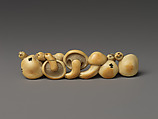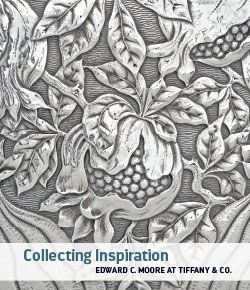String of Mushrooms
Since the kimono has no pockets, a Japanese man typically suspended items such as his inrō (a small container; see examples nearby), pipe, purse, and writing implements on a silk cord pulled through his obi sash. A small toggle, known as a netsuke, was attached to the other end of the cord as a counterweight to prevent it from sliding down. In the Meiji period, when Western garments gradually replaced kimonos, Western collectors such as Moore assembled large collections of these refined carvings.
The cleverly composed row of mushrooms, the lifelike pile of pea pods, and the delicate porcelain chestnut burr exemplify Moore’s interest in plant motifs.
Due to rights restrictions, this image cannot be enlarged, viewed at full screen, or downloaded.
This artwork is meant to be viewed from right to left. Scroll left to view more.




